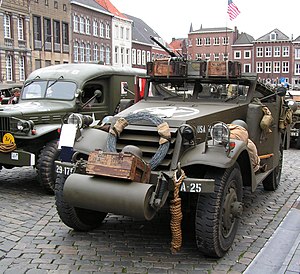M3 Scout Car
| M3A1 Scout Car | |
|---|---|

M3 Scout Car
|
|
| Type | Armored car |
| Place of origin | United States |
| Service history | |
| Wars | World War II, Second Sino-Japanese War, Chinese Civil War, 1948 Arab–Israeli War, First Indochina War, Algerian War |
| Production history | |
| Designer | White Motor Company |
| Manufacturer | White Motor Company |
| Specifications | |
| Weight | 8,900 lb (4.0 t) |
| Length | 222 in (5.6 m) |
| Width | 80 in (2.0 m) |
| Height | 79 in (2.0 m) |
| Crew | driver + 7 |
|
|
|
| Armor | 6–13 mm (0.25 inch sides, 0.5 inch windshield) |
|
Main
armament |
.50 cal (12.7 mm) M2 Browning machine gun |
|
Secondary
armament |
.30 cal (7.62 mm) Browning M1919A4 machine gun |
| Engine | Hercules JXD, 320 in3 (5,200 cc),L-head inline 6-cylinder, gasoline 110 hp (82 kW), compression ratio 6.5:1,Zenith Model 29 carburetor |
| Power/weight | 19.4 hp/t |
| Suspension | 4 x 4 wheel, leaf spring |
|
Operational
range |
403 km |
| Speed | 55 mph (89 km/h) |
The M3 Scout Car was an armored car in U.S. service during World War II. It was also known as the White Scout Car, after its manufacturer, the White Motor Company. It was used in various roles, including patrol, scouting, command vehicle, ambulance and gun tractor.
Design of the vehicle began at the White Motor Company, based in Cleveland, in 1937. It had .25 in (6.4 mm) face-hardened armor, full-time four-wheel drive (with no way to disengage it), four-speed manual constant-mesh (non-synchromesh) transmission (with one reverse gear) and two-speed transfer case, leaf spring suspension, manual steering, and (unusual for the period) vacuum-assisted (power) brakes. The wheelbase was 131 in (3.3 m), tread 65.25 in (1.657 m). The wheels were 8.5 in (220 mm) wide, 20 in (510 mm) diameter, and used standard 12-ply military non-directional tires. Fuel capacity was 30 US gal (110 l).
The original order was for 64 units, all of which were given to the 7th Cavalry Brigade. Eventually, the Army decided to adopt an improved version, designated M3A1. The new version had a longer and wider hull. In front of the bumper an unditching roller was mounted. The M3A1 could carry up to seven infantry and provide fire support with three machine guns - one .50 caliber (12.7 mm) and two .30 caliber (7.62 mm) - mounted on a skate rail around the hull.
Production of the M3A1 started in 1940 and lasted until 1944, with 20,918 vehicles built.
The design influenced the later U.S. halftrack designs, such as the M3 halftrack and the post-World War II Soviet BTR-40. The early M2 halftrack copied the armor layout as well as the skate rail machine gun mounts.
The M3 and M3A1 first saw combat with the Philippine Army and Philippine Constabulary in the Philippines in 1941 to 1960s, and was also used by the cavalry units of the US Army in the North African Campaign and the invasion of Sicily. It was used in traditional cavalry roles, such as scouting and screening; also as an armored command vehicle. By mid-1943, the drawbacks of the design - its open top, poor off-road mobility, and poor armament - were evident. During 1943, most US Army units replaced the M3A1 with the M8 armored car and similar M20 Utility Car. A small number of M3A1s were retained and employed in Normandy. A few M3A1s were used by the US Marine Corps in the Pacific theater, but none saw combat.
...
Wikipedia
